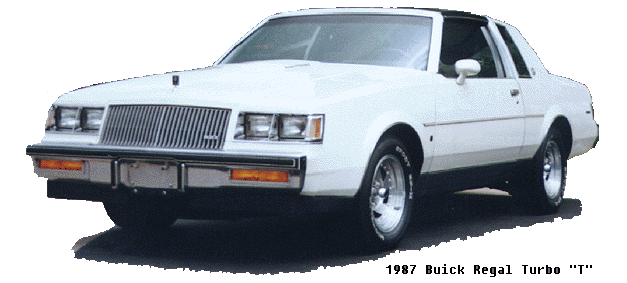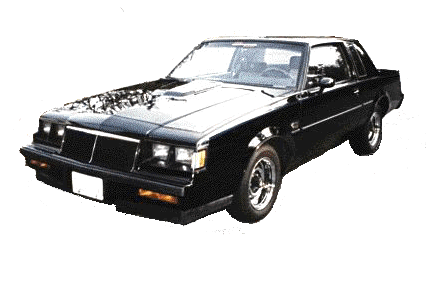

| Buick Performance — A Brief History |
|
Jim Radigan - jradiga9-2@idt.net
|
|
|


| The Search |
This article is the result of my searching for some basic stuff about the Turbo Regals. This need came about as I prepared to add one to my collection of Buicks (specifically a 1987 Regal Limited with turbo and T package, among other things). I knew them by reputation. However, I didn’t know if one would fit in my garage and, if it did, if I’d even like the thing. How does it ride? How does it handle? Will I go broke keeping gas in it? Is all of that legendary power really that readily available? Is it some kind of exotic that requires special care? Are the parts ridiculously expensive? And what are the first impressions?
| The Birth of the Regal |
The Regal (as we know and love it) was introduced in 1978 as Buick’s entry in the intermediate category. The nameplate hearkens back to 1973, but those early cars are radically different from the newer ones discussed here. It was introduced as an A-body in 1978, but its designation was changed to G-body in 1982, when the front-drive intermediates were introduced. All of the really hot turbo cars were introduced after this switch, so it is common to generalize and call the Turbo Regals (often abbreviated as TR’s) G-bodies.
All G-bodies ride on a 108.1 in wheelbase. Despite the changes in car shapes over the past 15 years, the Regal is still a mid-size car. It is, for all intents and purposes, the same size as, say, a Ford Taurus. It seats 2 in front (or 3, depending on front seat options) and 3 in back. Turbo Regals typically weigh between 3500 and 3900 lbs. It’s difficult to say precisely what a particular specimen weighs, as there was such an array of options available through the years. But in any case, you’re dealing with nearly 2 tons of car.
This heft helps give it a Buick ride. Buick engineers have been deeply involved in developing suspensions that delivered both a smooth ride and good handling, dating back to the early 60’s, if not before. All of Buick’s G-bodies benefit greatly from this heritage. The various suspension packages required over the years with the turbo motor option firm up the ride a bit, to give handling more to the enthusiast’s liking without a drastic loss of comfort.
| Many Flavors |
Turbo Regals came in a wide variety of flavors over the years. The most common were Grand Nationals (the black beauties) and T-Types (available in any color in that year’s Fisher Body rainbow). In the last years of the G-body run, the engine package was available as a Regular Production Order (RPO LC2) on any Regal. A TR could be had with just about any option available on a naturally-aspirated G-body. However, since a suspension upgrade was a mandatory option, the selection of factory wheels is dictated by the suspension package for a given year. This is also why TR’s always came with wider tires (which were always a part of the suspension package).
Because of the nature of turbocharging, the TR’s deliver admirable fuel economy in "normal" use. The EPA published estimates were 17 mpg city and 25 mpg highway. As you peruse the articles on this site, you will see that low-20’s highway mileage is a reasonable expectation. Coupled with an 18-gal fuel tank, a cruise range of well over 300 miles between fill-ups is typical.
| POWER! |
As for the availability of power, the GM engineers really got the TR’s dialed in. By the time the 1986 versions hit the street, turbo lag (the bane of the existence of many earlier turbo cars) had been banished. In reality, all that’s needed from a standing start to bring in all the ponies is some power braking. This will literally spool up the turbo and leave a cloud of rubber smoke behind when the brake is released. Buick had been working on the concept since the mid-70’s to provide big-block power without the big block’s appetite. The turbo V-6’s of the late 70’s delivered reasonable power, but the lag was an issue. With each successive model year, the boost came on quicker. In the early 80’s, with the advent of fuel injection and on-board computers, Buick could take the final steps (leaps?) in this process. Since the price of gas stabilized in the early 80’s, the entire turbo project shifted. Instead of simple daily-driver V-8 power, how about muscle-car power? The results speak for themselves. The nice thing is that, unlike the big-block power of old, the TR and the gas station are not necessarily close acquaintances.
| Enough Talk, Let's GO! |
OK, so how fast is this beast, anyway? The 0-60 times are seldom discussed any more. A car that is capable of high 13 to low 14 1/4 mile times straight from the dealer’s lot by definition gets to 60 mph "damn quick". Car and Driver reported a 4.9 0-60 blast that claimed the title "Fastest US Production Car of 1987". The beauty is that these cars can be "tweaked" so easily, that it is common for 12 second TRs to prowl the streets across the country. That’s why so many of them have appeared at drag strips over the past 2 decades. It also helps that the GM engineers put a lot of the "tweakable" things in plain sight or readily-accessed locations.
As for upkeep, there is a wealth of advice in to that end elsewhere on this site. Most repair parts are readily available, either at your local parts house or through the various suppliers listed on this site.
Although many GM people would disagree with this, it has seemed that, over the years, any car with a Buick nameplate has a better build quality than any of the other equivalent GM products. This is evident with the Turbo Regals, in that, considering the hard use many of them have been put through, there are still enough of them out there to justify, among other things, this very website.
As for technical help, this site is a great resource. There are also clubs available. The Buick Club of America is a good source for basic Buick information. Also, try out their newly-formed Performance Division. In addition, there is also the GSCA club, which was responsbile for a lot of the enthusiasm over these cars. There are many local/national clubs that will support your interest in these cars, as listed here. Your neighborhood Buick dealer is also a good resource, if you’re keeping the car stock, as well as various aftermarket Buick suppliers.
| New Owner's Impressions |
My first impressions? My Limited is fully loaded in the luxury style, down to the heavily-padded vinyl top and opera lights on the outside and the velour loose-cushion look interior. After a good tune-up, it goes like the proverbial bat out of hell. Not only is it quick off the line (if power-braked), it builds boost virtually any time on demand. It handles like it’s on rails (no mean feat, considering its weight). It’s giving me mid-teens gas mileage around town and low 20’s on the highway. It’s as close to the complete package as I’ve ever driven.
Fast, comfortable and reasonably economical. Not bad!
Last updated: